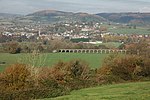Monmouth School for Boys is a public school (independent boarding and day school) for boys in Monmouth, Wales. The school was founded in 1614 with a bequest from William Jones, a successful merchant and trader. The School is run as a trust, the William Jones's Schools Foundation, by the Worshipful Company of Haberdashers, one of the livery companies, and has close links to its sister school, Haberdashers' Monmouth School for Girls. In 2018, the Haberdashers renamed their group of schools in the town, the Monmouth Schools, and made corresponding changes to the names of the boys' and girls' schools.
The school is situated on the eastern edge of the border town of Monmouth, adjacent to the River Wye. Nothing of the original school buildings from the 17th century remains as the school was completely rebuilt in the mid to late 19th century. Later developments have included the Science Block (1981–1984) and the William Jones Building of the early 21st century (2014). In 2014, the quatercentenary of the school's foundation was celebrated with a service at St Paul's Cathedral.
Established originally as a grammar school, by the early 1870s Monmouth was a member of the recently formed Headmasters' Conference and had acquired the status of a public school. Between 1946 and 1976 it was part of the direct grant scheme, returning to full independence in 1976. A member of the Headmasters' and Headmistresses' Conference, the school has a roll of approximately 650 pupils. The fees for 2019/2020 are £16,275 for day boys, and £30,852 for boarders. The William Jones's Schools Foundation, which funds the Monmouth Schools on behalf of the Haberdashers’ Company, recorded an income of £20.5M against an expenditure of £24.0M in its accounts for 2020. In June 2022, the Haberdashers initiated a consultation on merging the school with the girls school in the town to create a fully coeducational establishment by 2024.









